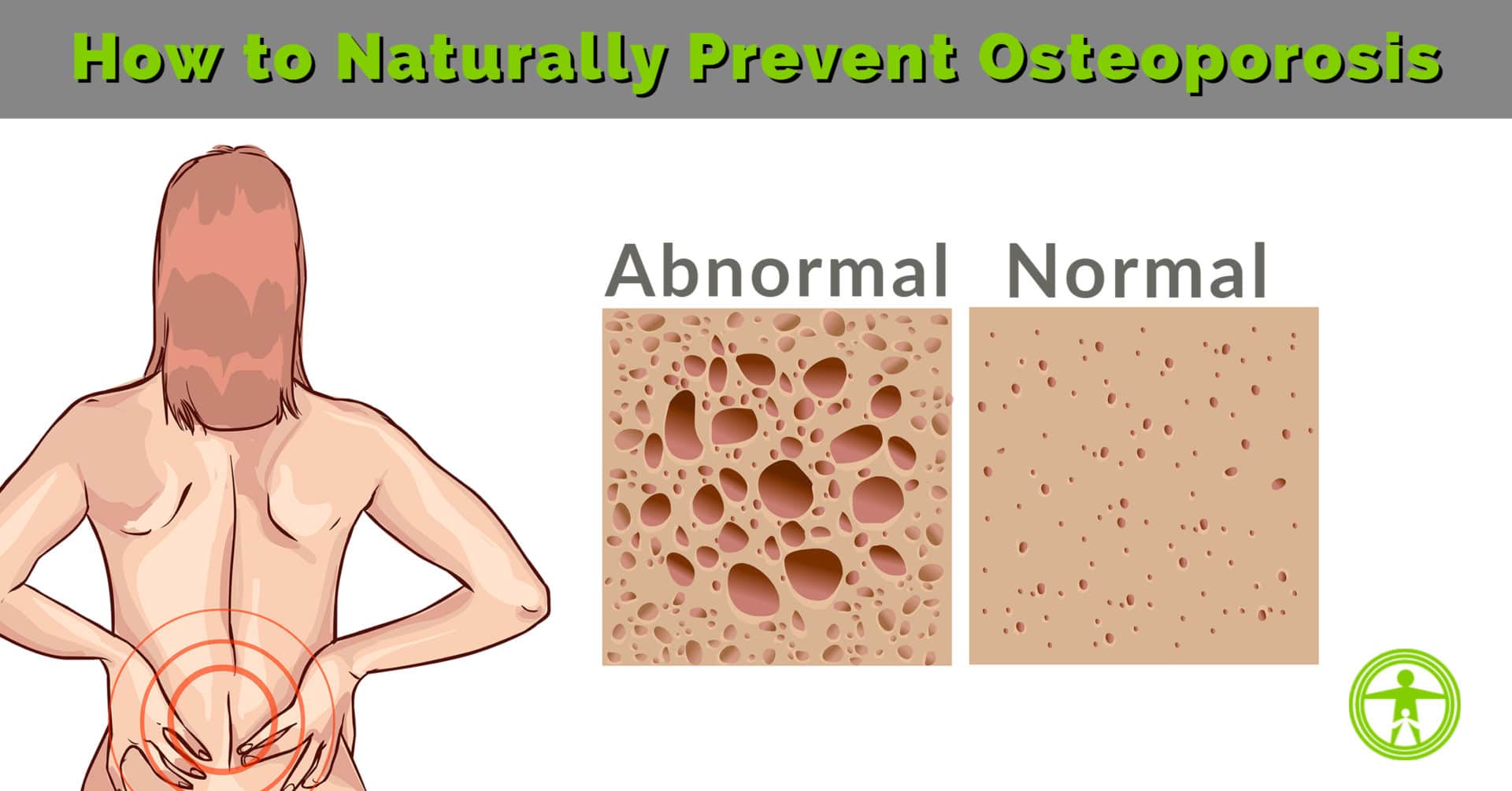So many people have been taught that osteoporosis is a normal result of aging and not having enough calcium.
However, the truth is that age and low calcium are not the only risk factor for osteoporosis.
In fact, age isn’t as big of a risk factor as hormone imbalance or poor nutrient status.
Osteoporosis is a disease characterized by the thinning and deterioration of your bones.
When bones start to lose calcium, they become brittle and break.
But calcium isn't the only mineral you need for strong bones.
Other nutrients include:
- Magnesium
- Zinc
- Copper
- Manganese
- Potassium
- Boron
- Vitamin C
- Vitamin K
Calcium is not the most important supplement to prevent Osteoporosis!
Without a doubt, physical activities such as walking, Yoga, Tai Chi ans strength training are some of the most effective means of preventing osteoporosis.
Promoting hormone and nutrient balance are additional steps in preventing osteoporosis.
Bone loss after age 30 increases significantly, which is why age appears to be a huge factor. But just like you should build wealth over time, the same is true with health.
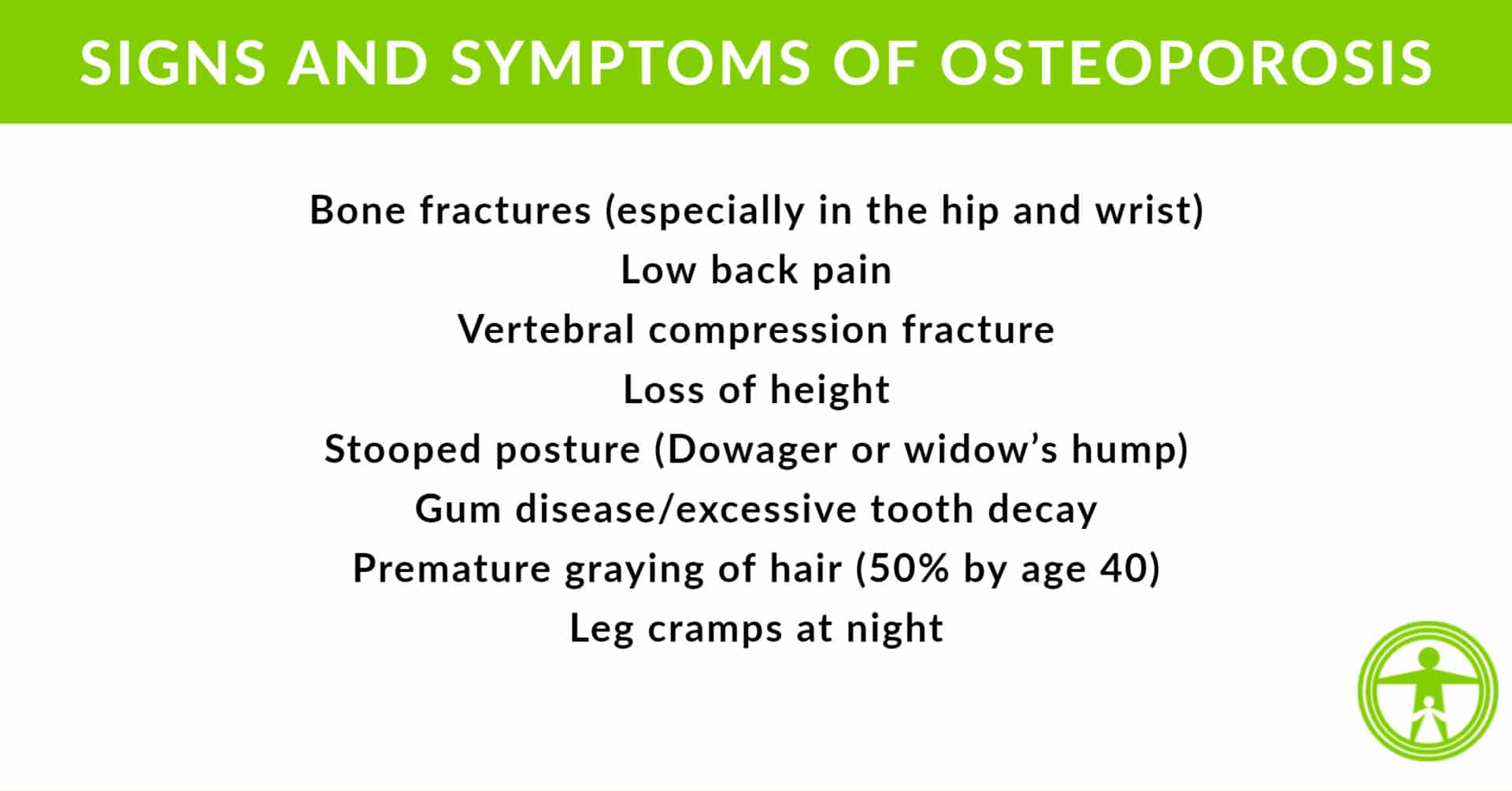
Signs and Symptoms of Osteoporosis
How can you tell you have osteoporosis? Initially, you won’t have any symptoms. However, as this condition progresses you may experience:
- Bone fractures (especially in the hip and wrist)
- Low back pain
- Vertebral compression fracture
- Loss of height
- Stooped posture (Dowager or widow’s hump)
- Gum disease/excessive tooth decay
- Premature graying of hair (50% by age 40)
- Leg cramps at night
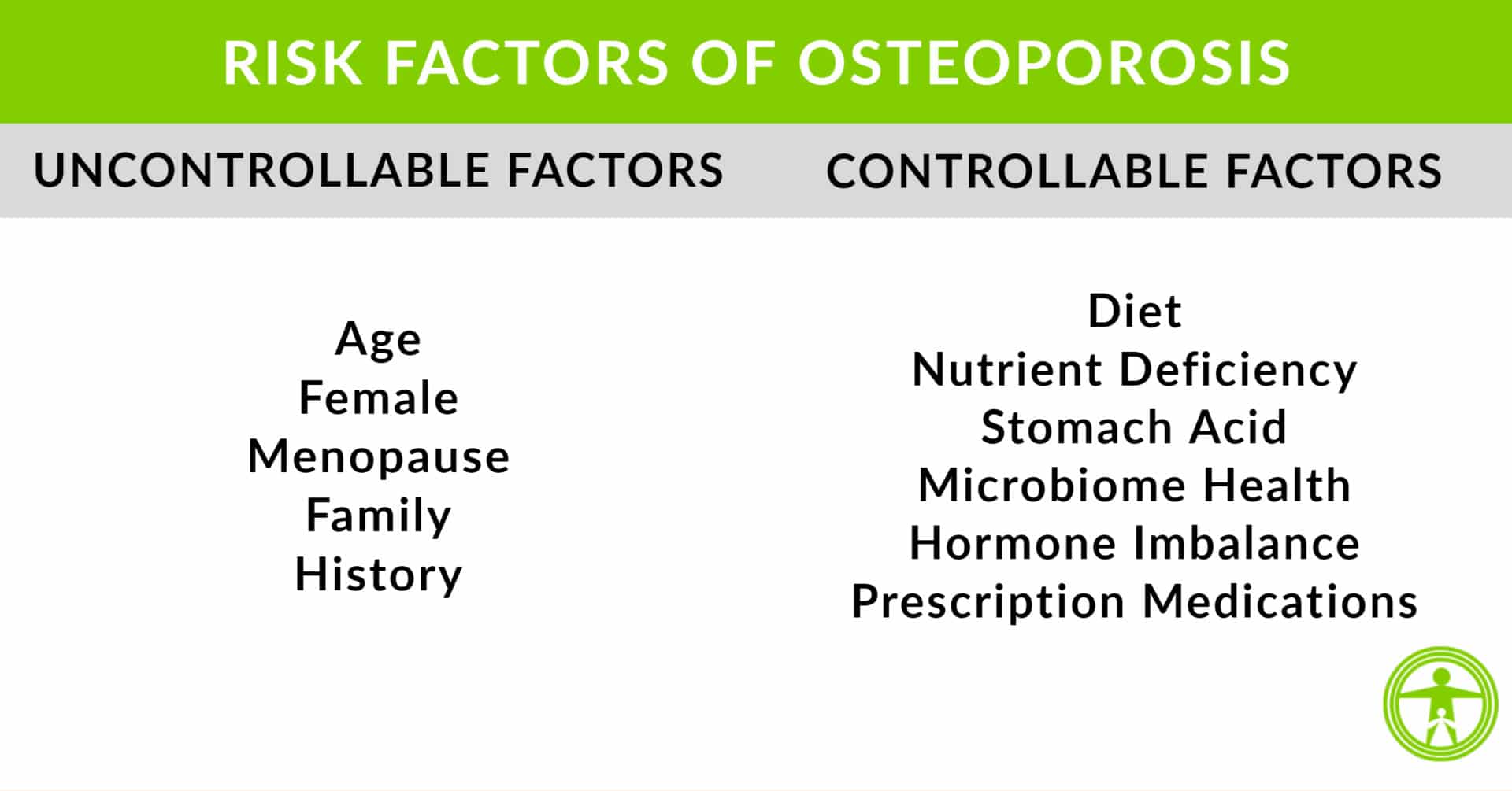
Osteoporosis Risk Factors
When it comes to osteoporosis, there are some risk factors within your control and then there are those that are out of your control.
Uncontrollable osteoporosis risk factors:
- Age (>50yrs)
- Female
- Menopause
- Family history
Controllable osteoporosis risk factors:
- Eating acid-forming foods (excessive meat, coffee, sugar, sodas)
- Nutrient deficiencies (Ca, Mg, K, D3)
- Low stomach acid and antacid usage
- Lactose intolerance
- Poor gut bacteria
- Low estrogen
- Low androgens (DHEA and testosterone)
- Birth control pills
- Vitamin D deficiency
- Sedentary lifestyle
- Smoking
- Medication
- Heavy metals found in the body (cadmium and lead)
Have you noticed that so many more risk factors are in your control?
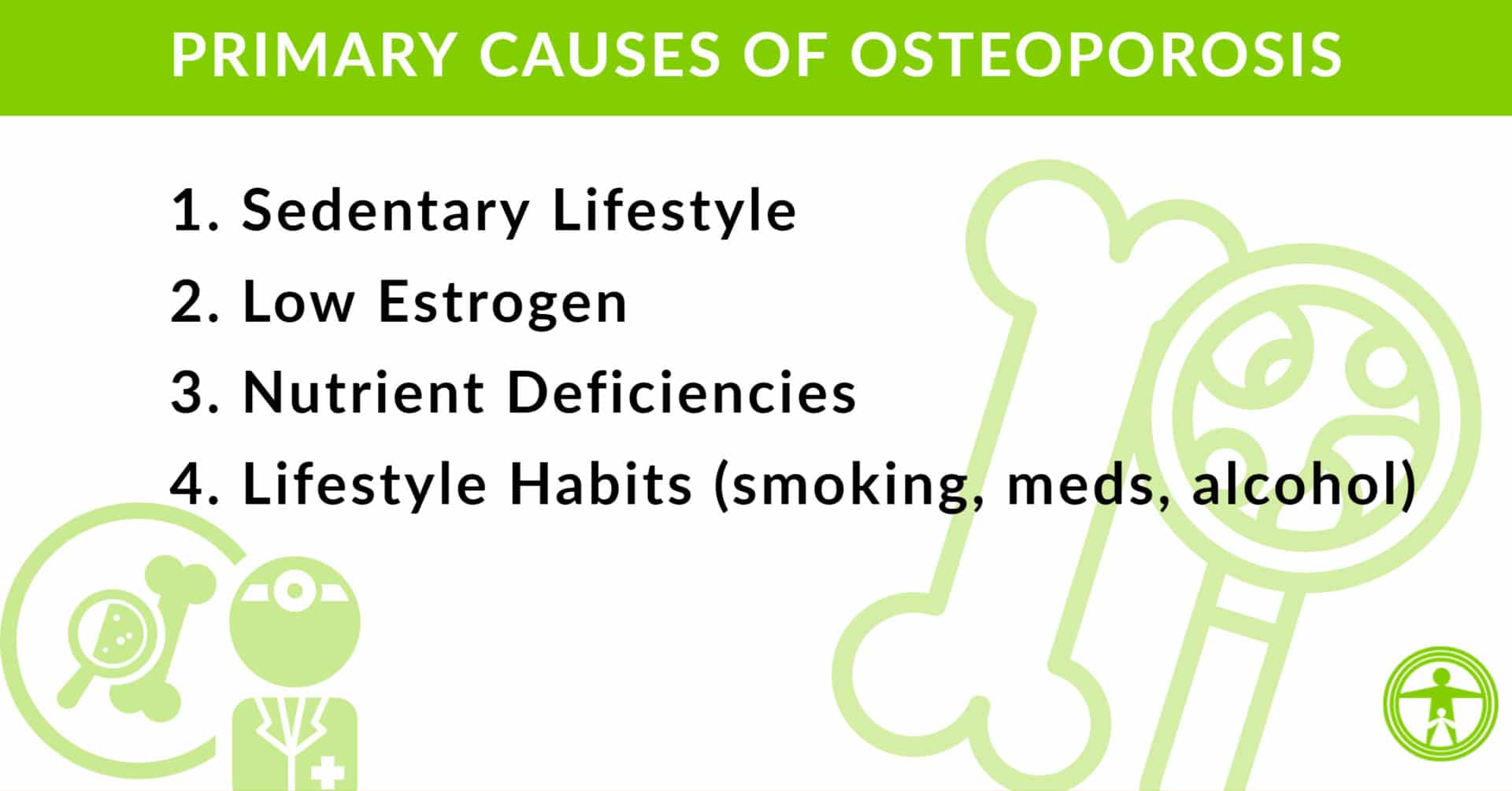
Primary Causes of Osteoporosis
There is a process of growth called ‘remodeling’ that goes on within healthy bones.
Each bone uses osteoclast cells to break down old and weak bone. And osteoblast cells are used to build new, strong, and healthy bone.
When this process is altered, it signals an imbalance is happening in our body. We are now learning age and a low calcium diet are not the only reasons to blame, but instead an imbalance of the remodeling process.
1. Sedentary lifestyle
The saying “If you don’t use it, you lose it” is so true when it comes to our bones.
Exercise increases the secretion of a thyroid hormone called calcitonin in our body. Calcitonin inhibits osteoclast (bone breakdown) – yet another example of hormones affecting our bones.
Weight training is especially beneficial for osteoporosis.
One really cool (I think) aspect of the chiropractic adjustment, beyond its effect on joint motion and the central nervous system, is the effect it has on the process of bone breakdown and replacement.
A chiropractic adjustment stimulates the cells that are in charge of replacing bone (osteoblasts).
So when one receives a chiropractic adjustment, they are not only improving joint motion and the health of their nervous system, they are also giving a positive boost to the strength of their bones.
Getting adjusted supports the health of your bones and prevention of osteoporosis, as well as assists in the process of reversing it.
2. Low estrogen
On a cellular level estrogen is needed to inhibit osteoclast (bone break down activity). When you have estrogen deficiency, this speeds up bone resorption causing low bone density – resulting in increased fractures.
Estrogen deficiencies are not only found in postmenopausal women but also include:
- Young women with amenorrhea (thin athletes, very low body fat, anorexia)
- Women with bilateral oophorectomy (both ovaries removed)
The same is true with testosterone deficiency in males.
Androgens prevent the loss of bone density and promote bone formation. But we all know the prevalence of osteoporosis in women far exceeds men’s prevalence.
So why is it so important we also focus on a hormonal deficiency in men?
Studies show that the mortality rate in men is significantly higher after a hip fracture than women.
3. Nutrient deficiencies
Bone matter consists of a few things that are needed to give your bones hardness and flexibility:
- Calcium and phosphorus crystals
- Protein fibers (collagen)
Our bones house the majority of calcium and phosphate found in our body.
Vital nutrients for bone health and their roles:
- Calcium – maintains bone strength and is the essential building block
- Zinc – increases osteoblast and mineralization
- Copper – helps with bone flexibility and strength
- Magnesium – increases osteoblast and regulates the concentration of Vitamin D
- Potassium – neutralizes metabolic acids
- Vitamin C – synthesizes healthy collagen and regulates homeostasis for healthy bones
- Vitamin D – facilitates calcium absorption in the intestines and critical in bone remodeling
- Vitamin K – aids in calcium absorption and improves bone turnover
You can see how important all of these nutrients are in building strong healthy bones.
This is why we also focus on these deficiencies in our body – to determine if this could be the cause of osteoporosis.
The easiest way to become nutrient deficient is to not eat enough food in the first place.
4. Lifestyle Habits
Smoking
To add to the long list of negative effects smoking has on your body – it also decreases your bone density mass. Smoking increases the breakdown of estrogen in the liver. Smoking also has been proven to cause early onset of menopause in women.
Medications
Drugs like proton pump inhibitors, selective inhibitors of serotonin, hormone deprivation therapy, and glucocorticoids negatively affect bone density – increasing bone fractures.
Alcohol
Alcohol interferes with calcium absorption. So, it is no surprise that heavy alcohol consumption can lead to decreased bone density, bone formation, and increased fractures.
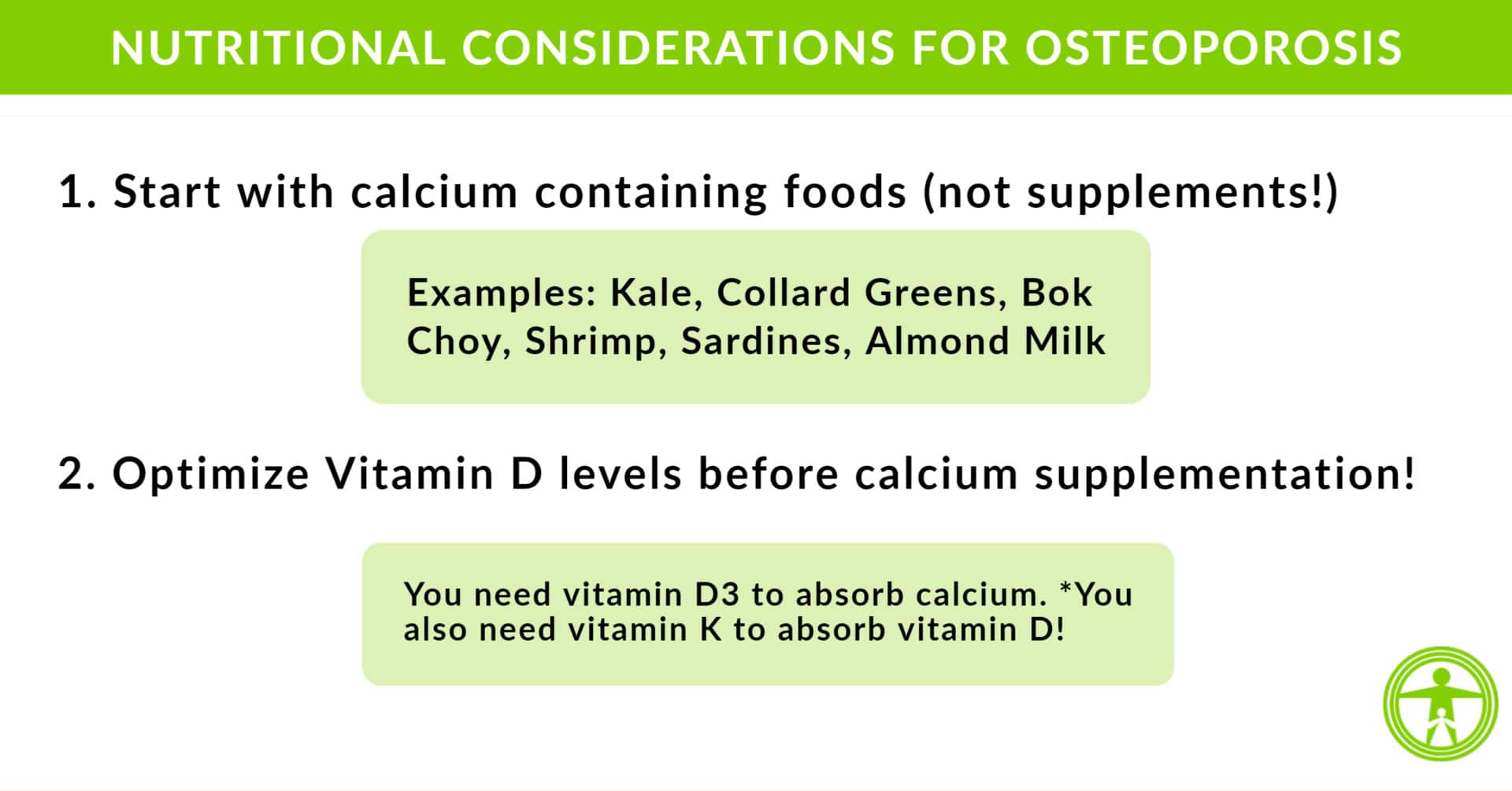
Best Nutrition For Osteoporosis
Start with eating calcium-rich foods:
- Broccoli
- Kale
- Collard greens
- Bok Choy
- Shrimp
- Sardines (with bones)
- Almond milk
Don’t forget Vitamin D (I use this supplement) is needed to absorb calcium so pair your calcium-rich foods with:
- Fatty fish, like salmon or tuna
- Orange juice
- Egg yolks
- Cheese
Dairy is also a good source of calcium, but I don’t recommend it due to increased food sensitivities to most dairy products such as milk, cheese, yogurt, and butter.
The dairy industry has created the need for dairy consumption by instilling fear in women that avoiding dairy will cause weak bones. To debunk this, let me offer you this analogy: Traditional Chinese cuisine never used any dairy and historically Chinese women had no problems with osteoporosis (this is changing now with Western food entering China).
Another analogy: cows don’t eat dairy and don’t seem to have a problem with their bones :-).

